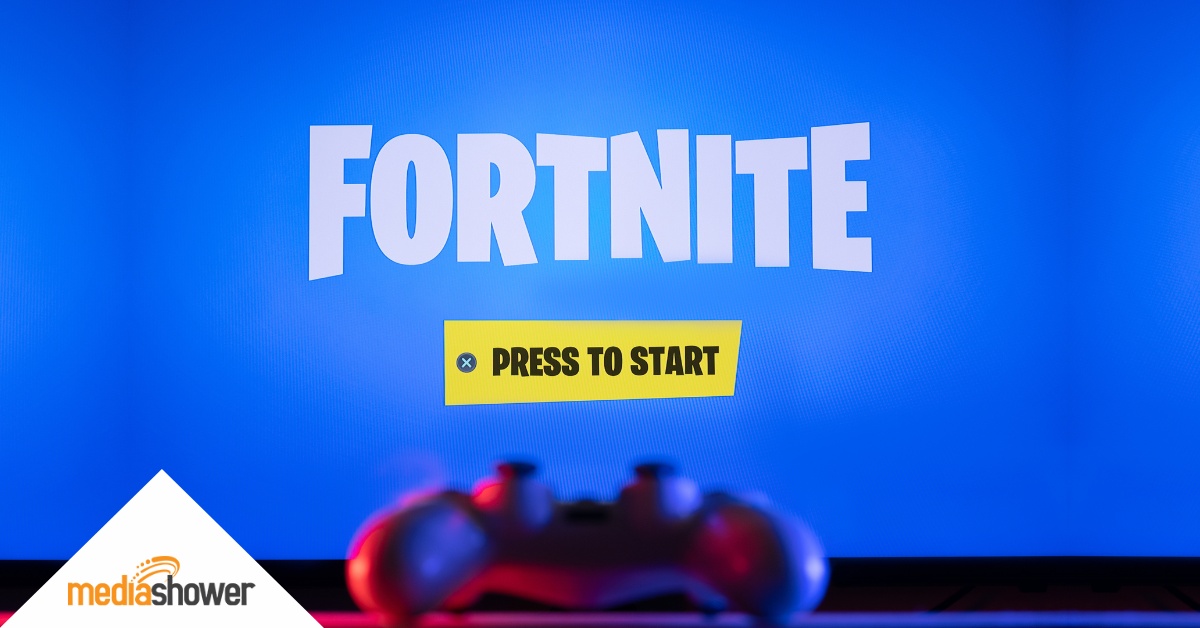
When Eminem appeared inside Fortnite for a 12-minute digital concert, more than 11 million players logged in simultaneously. Tickets were free, seats were virtual, and the arena was global.
Fortnite’s evolution from free-to-play battle royale to multi-billion-dollar cultural engine shows how entertainment can become marketing’s most powerful stage.
Fortnite has built its own in-game universe, pulling in musicians, fashion houses, and Hollywood studios. Through scarcity, collaborations, storytelling, and spectacle, Epic Games transformed a game into a platform where culture itself is playable. Here’s how.
1. Treating the Product as a Platform
What launched as a shoot-em-up game quickly morphed into a digital hub where entertainment, commerce, and creativity collide. Players don’t just compete; they attend concerts, watch movie premieres, and join fashion shows inside the same space.
The numbers prove the platform effect. Eminem’s December 2024 Fortnite performance drew over 11 million live attendees. Ariana Grande, Travis Scott, and Marshmello all staged immersive events inside Fortnite as well.
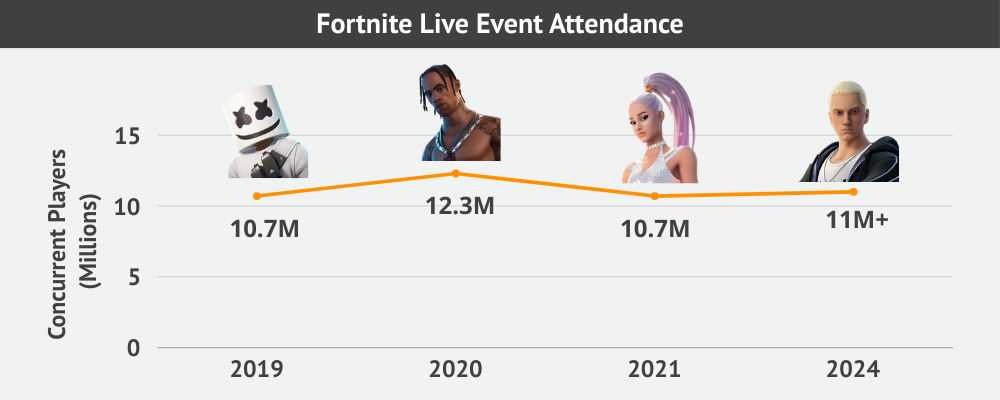
2. Seasonal Scarcity Creates Constant FOMO
Every new Fortnite “season” comes with new maps, skins, and challenges, all released on a countdown that makes the timing feel urgent. Skins and items often disappear after the season ends, creating a sense of exclusivity that fuels both engagement and spending.
This strategy has delivered staggering revenue. Between 2018 and 2019, Fortnite generated more than $9 billion, largely from cosmetic sales. Players buy skins and emotes because the items are fleeting. Scarcity drives loyalty and repeat visits, so each new season feels like a limited-run show.
The daily engagement metrics confirm this dynamic. In 2023, Fortnite averaged over 25 million daily active users, showing that scarcity-driven mechanics keep players logging in consistently year after year.

3. Turning Collaborations Into Cultural Collisions
Collaborations are common in marketing, but Fortnite raises them to cultural scale. Every partnership is more than a licensing deal. Marvel characters came bundled with a full narrative arc. Nike built sneaker culture into a playable map. LEGO designed a creative mode for kids to build directly inside the game.
The strategy encourages community crossovers. Since its release, Fortnite has introduced over 400 branded skins, each one attracting fans from different corners of pop culture. These collaborations are integrated into gameplay, storylines, and identity.
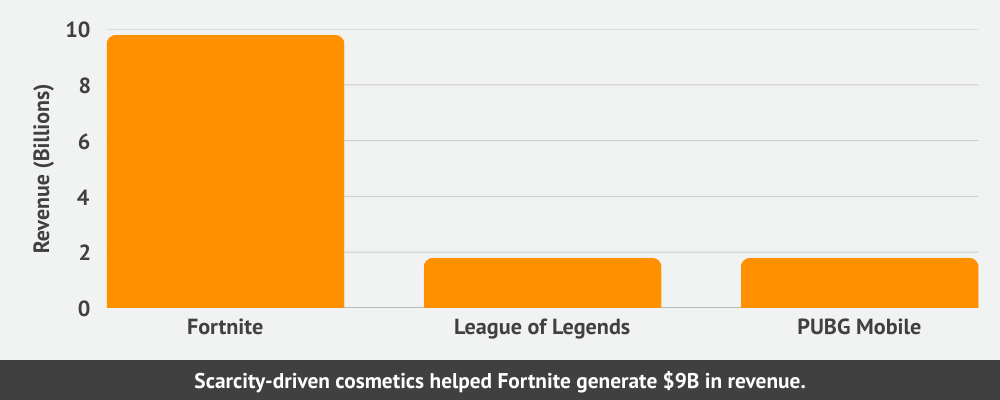
4. Making Ads Playable, Not Passive
In Fortnite, advertising is something players choose to wear, drive, or swing in battle. Balenciaga released outfits that avatars could buy. Marvel let players embody superheroes. Nike launched Airphoria, a custom world where sneaker fans could unlock virtual collectibles linked to physical items.
Fortnite has perfected advertising that immerses instead of interrupting. The brilliance lies in making ads indistinguishable from identity. Players don’t think of themselves as wearing a brand; they think of themselves as becoming part of the world that brand creates.

5. Building Hype Through Live Events
Fortnite events are cultural happenings. When rapper Travis Scott entered Fortnite, his Astronomical concert attracted 45.8 million in-game viewers, a record-breaking feat at the time. Millions more watched on streaming platforms.
The scale turned a virtual concert into a mainstream entertainment story. Suddenly, Fortnite was on Billboard charts, in Rolling Stone reviews, and on morning news shows. The spectacle created value beyond the screen by reaching people who had never played the game.
In 2021, Ariana Grande’s Rift Tour expanded that reach. Including streams and replays, more than 78 million people watched her performance across platforms.
6. Storytelling That Evolves With the Audience
In each new season, Fortnite also releases evolving storylines, with new plot twists and mysteries, weaving gameplay into serialized drama.
The most famous example remains the “black hole” Epic Games created in 2019 as a dramatic in-game finale to mark the end of the game’s tenth season. Players watched “The End” as rockets exploded, rifts appeared, and the entire game map was sucked into a black hole.
Epic Games shut down the servers and displayed nothing but a black void for two days. The move sparked massive coverage in outlets like The New York Times. Fans speculated wildly online, turning absence into anticipation.
Stories keep audiences curious. They invite return visits, loyalty, and a sense of shared journey. For marketers, weaving narrative into products ensures that customers keep looking forward to what comes next.

7. Elevating User-Generated Content Into Prime Time
Epic Games gave players the power to create their own worlds with Fortnite Creative. What could have been a side feature turned into a pillar of engagement. Players design their own game modes, some of which attract millions of visits.
When Epic highlights these fan creations or elevates them into official playlists, it validates the community’s role in shaping the platform. According to Polygon, some fan-made maps have surpassed official content in popularity.
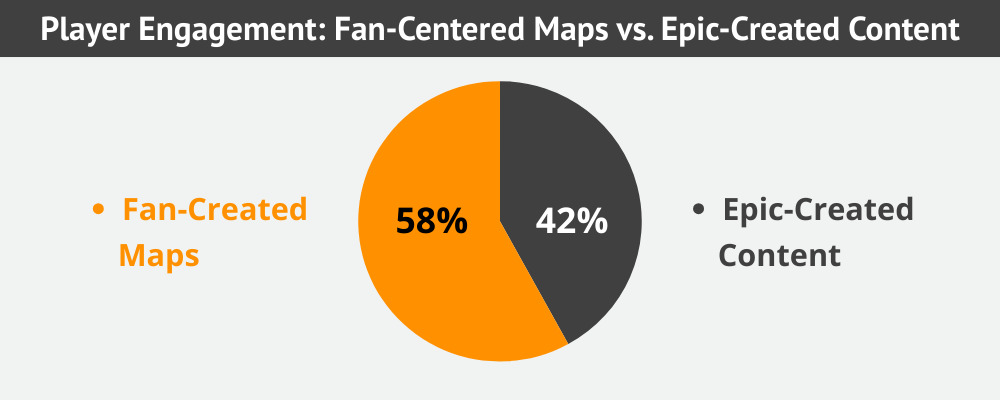
User-created maps often surpass official maps in popularity.
8. Engineering Spillover Into Mass Media
Fortnite understands that the real prize isn’t just in-game engagement; it’s cultural spillover. Events are designed to be dramatic enough for mainstream coverage. The 2019 black hole event was reported by CNN like a breaking-news crisis, even though it was a marketing stunt.
Another standout example is HI-CHEW’s Chewbie-Dome campaign, which was launched in August 2025. The activation turned Fortnite into a branded playground with five custom mini-games, influencer-judged competitions, and unlockable social challenges.
Popular creators like Birdo and Dagwummy produced and shared branded gameplay across YouTube, Instagram, and X, encouraging fans to join in and post their own clips. The result wasn’t limited to Fortnite’s Creative hub; it spread across social feeds, video platforms, and branded recap reels, amplifying HI-CHEW’s visibility well beyond the game itself.
This kind of spillover turns brand activations into free publicity. It ensures non-players see the spectacle and feel like they missed a cultural event. The strategy works because the moments are visually striking, mysterious, or socially shareable enough to break into headlines.
9. Blurring the Lines Between Gaming and Fashion
Fashion has found a new frontier in Fortnite. For younger audiences, digital outfits carry as much cultural weight as physical clothing. Fortnite has embraced this by collaborating with major fashion brands.
One striking example came when Balenciaga partnered with Epic Games to release skins in tandem with a real-world streetwear line. As Vogue Business (paywall) reported, the drop blurred the boundaries between physical fashion and digital identity, allowing players to mirror their real-life style in-game.
10. Building a Community That Feels Like Culture
Fortnite’s marketing success comes not only from spectacle but from the community that surrounds it. Within its first 18 months, the game surpassed 200 million registered users. That base has grown from an audience to a massive culture.
The vibrancy of this community shows up across streaming platforms, too. In December 2023, the game had been viewed a total of 107 million hours. By 2025, that number had exploded to 35.5 million hours—in the month of June alone.
YouTube views for Fortnite content remain massive, with over 3.1 billion on the official channel alone, and much higher when including all creators.
Epic nurtures this community through social gameplay, player spotlights, and constant content drops. The effect is a player identity that feels akin to supporting a sports team or joining a movement.
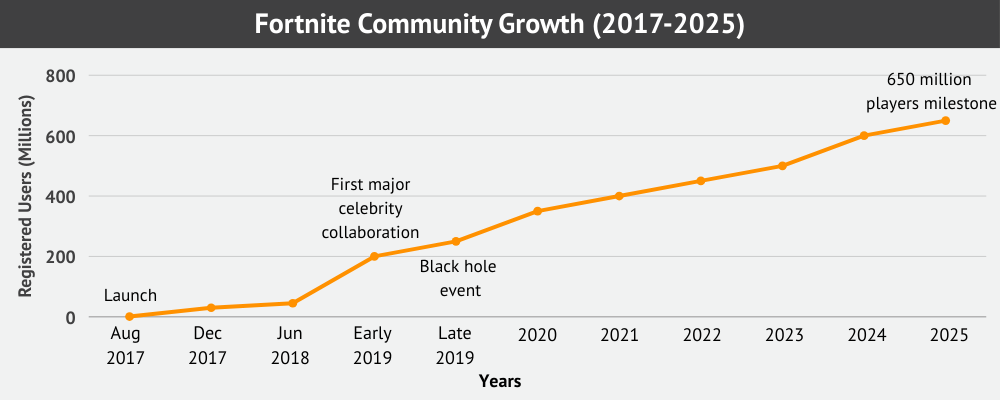
Fortnite has seen astronomical growth since its 2017 launch.
Fortnite’s success shows the power of building an ecosystem where stories, brands, and communities grow together. It’s a model that turns engagement into loyalty and culture into lasting impact.
Want to learn more about Fortnite’s marketing prowess? See our FAQ below.
Marketer Takeaways
- Think like a platform: Build ecosystems, not just products, where your brand becomes a launching pad for others.
- Harness scarcity: Use limited drops and seasonal updates to energize audiences and create buzz.
- Engineer collaborations: Mash up brands and communities for surprise and delight.
- Make it participatory: Let your audience live and play with your brand, not just watch passively.
- Tell ongoing stories: Encourage loyalty with serialized narratives and evolving arcs.
- Elevate your community: Spotlight contributions and turn fans into co-creators.
- Blur categories: Partner with industries that give your brand new context and meaning.
- Foster belonging: Build a brand community that feels more like a movement than a campaign.
Media Shower’s AI marketing platform helps brands build cultures that click, connect, and convert. Click here for a free trial.
Frequently Asked Questions
Why is Fortnite considered a marketing powerhouse?
Because it has expanded beyond gaming into music, fashion, film, and brand collaborations, turning itself into a cultural platform rather than just a product.
How much revenue has Fortnite generated?
Fortnite earned over $9 billion in its first two years, largely from cosmetic purchases and limited-time content.
What are the biggest Fortnite collaborations?
Epic Games has partnered with Marvel, Nike, LEGO, Star Wars, and luxury fashion houses like Balenciaga, offering skins and in-game experiences tied to those brands.
How does Fortnite use FOMO in its strategy?
It relies on limited-time items, rotating seasons, and exclusive events to encourage urgency and repeat engagement.
What can brands learn from Fortnite?
Treat your product as a platform, use scarcity strategically, lean into storytelling, and create experiences that fans want to share across cultures.